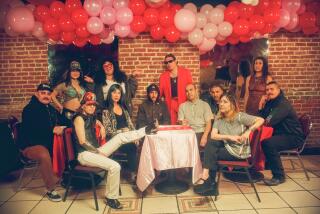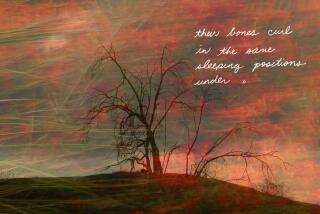A Flock of Angels Makes Us Downright Euphoric
Few responses to Calendar--or to any publication, for that matter--address the experience of reading an issue as a whole. The Calendar of June 14, for example, featured reviews of the play âCity of Angels,â and of the movies âBright Angelâ and âAn Angel at My Table.â Nowhere in the issue was this gathering of angelic titles noted, much less was the question raised, why? Why the profusion of heavenly imagery?
If angels gather on Page 1 of Calendar, it must be because theyâre hovering, so to speak, over the culture just now. That same June 14 issue naturally included the usual TV listings for the daily reruns of âHighway to Heavenâ (in which the late Michael Landon plays an angel on Earth) and of âCharlieâs Angels,â and even a live baseball broadcast on Channel 5 of the California Angels at Boston.
Certainly we who live in the city or county of angels are particularly sensitive or attuned to this question. You might even say that angels flock to these parts, given Hollywoodâs love affair with angels, from the Frank Capra classic âItâs a Wonderful Lifeâ (1946) to this yearâs âDefending Your Life.â Current popular music and the accompanying rock videos are also full of angels lately. To the extent that theyâre on the air (and on stage, and in print), angels are âin,â not only but especially in L.A.
Beyond the industrial fact that Hollywood serves as angel-purveyor to the world, we still have to ask âWhy now?â Why so many angels on one page, and Page 1 at that? You could probably fill a book with reasons, but one of them might be called the hidden strand of euphoria in contemporary culture.
Our TV, movies, newspaper--in short, our culture--keep sending us or bringing us angels. In quality fiction, for instance, check Vicki Covingtonâs recent and easy novel âBird of Paradiseâ or go back to Thomas Pynchonâs difficult and rewarding âGravityâs Rainbowâ (1973) to see that the most thoughtful portraiture of angels runs right through our period. Go further back to the Bible if you want the earliest sources, or to Dante, Milton, Swedenborg or Rilke for later monuments of âpneumatology,â as the professors call angelic lore. Consult Islam for still more. Humans have filled paper and film with angels as far as the eye can see.
The message the angels in our culture seem to be bringing us this time is that this is heaven right here. In some ways, it is a wonderful life. In one of the best of angel movies, Wim Wendersâ âWings of Desireâ (1987), the angels envy the humans. They would gladly trade their wisdom and their immortality for a taste of the intense vitality we get to live every day. In Steve Martinâs recent comedy âL.A. Story,â you could say that the angel is played by an illuminated freeway sign--but the implication of euphoria is the same.
So while the news media go about their business of reminding us how far, how often tragically far, we are from perfection, the arts and popular culture both have been surreptitiously implying that the angels are us . These are, after all, human images. We made them real, out of our imaginations.
Whether you tune in the Joffrey Balletâs performance of Gerald Arpinoâs âRound of Angelsâ on the Bravo cable channel or go to watch the Angels play in Anaheim, the hidden signal of euphoria--of what the kids are calling âdee-liteâ--comes through loud and clear.
And thereâs another important answer to the question of âWhy now?â What, after all, are angels? Theyâre images in human form that have no actual substance, but can transport themselves from place to place instantaneously. That is in fact what those wings signify: no weight and instant travel. Do we have anything like that in 1991? Of course: the global, or even local, televised image. Every time you see a figure on the screen, it has something angelic about it: human-looking and human-sounding, but immaterial and transmitted instantly, as if on wings, about the globe. So in this latter half of the century, we have constructed angels, in inconceivable numbers.
And if our culture is suddenly taking heed of angels (be they lost, fallen, bright, at my table, or from a âCityâ), it may be because itâs dawning on us that weâve surrounded ourselves with them, metaphorically, in our torrent of instant global representations.
The culture has lost much of its accustomed bitterness, thatâs the bottom line. It has gotten sweeter. These angels--even if they do appear only as a word in a title, and nowhere else in the work--are a symptom of that sweetness, of a renewed willingness by writers of every stripe to consider how extraordinary are the conditions of existence, here at the top of the food chain, at the end of the century.
As the radio-wrapped and now satellite-surrounded world has shrunk in our imaginations, so has our sense of the universe around it grown--a universe that seems more evidently than ever devoid of life, except for right here. A triply angelic front page of Calendar, whether by accident or design, suggests that the power of these imaginary figures to raise our sense of lifeâs genuine uniqueness has never been stronger.
More to Read
Sign up for our Book Club newsletter
Get the latest news, events and more from the Los Angeles Times Book Club, and help us get L.A. reading and talking.
You may occasionally receive promotional content from the Los Angeles Times.








